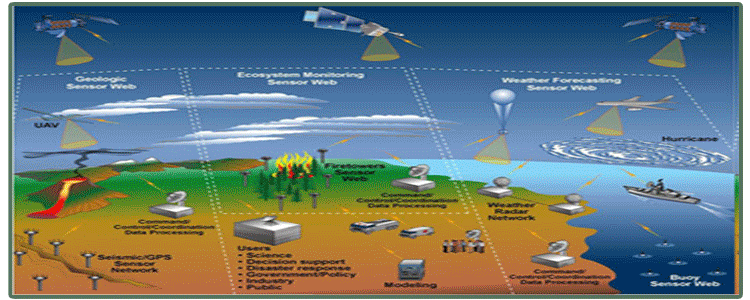

Communication and Network Group
The research activities of the Communication and Network Group revolve mainly around communications, signal processing, information security, optical fiber transmissions, computer networks and electric wave modeling. The main research initiatives include multimedia compression and processing techniques; image processing and pattern recognition; information security; digital communications and optical fiber transmissions; microwave engineering and high-speed fiber transmissions; EMI/EMC modeling and measurement; bio-electromagnetics; radio wave propagation; medical engineering; mobile communication systems and protocol design; radio resource management for wireless networks; channel estimation and signal detection in wireless communications and computer networks.
The Communication and Network Group cooperates extensively with local companies and organizations and is renowned throughout Taiwan for the quality of its R&D activities and the standard of education and training which it provides.

Tele-communication
Mobile Communication
Internet Technology
Network Security
Cloud Computing
Multi-media Application
Computer Engineering
Szu-Lin Su
Huey-Ru Chuang
Stanley Liu
Wen-Kuang Kuo
Wenson Chang
Kuang-Wei Cheng
Kuei-Chiang Lai
Chih-Ming Tsai
Ming-Xian Chang
Kuo-Feng Ssu
Sok-Ian Sou
Chu-Sing Yang
Hui-Tang Lin
Jung-Shian Li
Jen-Fa Huang
Jung-Shian Li
Hui-Tang Lin
Jen-Wei Huang
Jar-Ferr Yang
Chin-Hsing Chen
Lih-Shyang Chen
Shen-Chuan Tai
Lih-Shyang Chen
Pau-Choo Chung
Chung-Ho Chen
Jing Chen
Ce-Kuen Shieh
Hewi-Jin Jiau
Communication and Network Group
Lab
Advisor
image Lab
Advisor
Chin-Hsing Chen professor
Lab
Advisor
Electromagnetics Lab
Advisor
Eric Chihming Tsai professor
Lab
Advisor
CANS Lab
Advisor
Jung-Shian Li professor
Cloud and Network Security Laboratory, CANS Lab, is formerly known as High-speed Network Laboratory, HSNET Lab. The Lab focuses on the cloud network management and security-related research and practice. The main research covers network security, network communications, network traffic management, cloud computing, digital forensics, IoT, botnet, VANETs and other fields as well. The Lab published numerical papers on IEEE Transactions and other well-known journals and completed implementation of prototypes of several cloud security systems, and achieved several invention patents. Most graduate members serve in telecommunication companies, netcom manufacturers or related institutions and universities. Basically, M.S. student before graduation in the Lab should publish a conference paper at least.
Lab
Advisor
CSP Lab
Advisor
Ming-Xian Chang professor
Lab
Advisor
Wireless Communication and Network Lab
Advisor
Wenson Chang professor
Wireless communication and network laboratory (WCN) was founded by Dr. Chih-Wen (Wenson) Chang in Department of Electrical Engineering, National Cheng Kung University in August 2006. The current research interests of the WCN Lab include radio resource management (RRM) and cross-layer optimization for the wireless communication systems. Recently, we have investigated several critical RRM issues for the 3.5G, 4G and more advanced wireless communication systems, e.g. WCDMA, HSPA, MC-CDMA, OFDM-based and CR systems.
Now, we are interested in the following and related issues:
1. Radio resource management for the 4G, 5G, femto-cell systems and CR network.
2. Performance analysis and optimization for cooperative communication system.
3. Application of Game theory to the wireless communication systems.
4. Adaptive cellular architecture design, including adaptive frequency planning and sectoring with aids of distributed antenna system and relays.
5. Cross-layer design and optimization for advan.
Now, we are interested in the following and related issues:
1. Radio resource management for the 4G, 5G, femto-cell systems and CR network.
2. Performance analysis and optimization for cooperative communication system.
3. Application of Game theory to the wireless communication systems.
4. Adaptive cellular architecture design, including adaptive frequency planning and sectoring with aids of distributed antenna system and relays.
5. Cross-layer design and optimization for advan.
Lab
Advisor
Broadband Communications and Signal Processing Lab
Advisor
Kuei-Chiang Lai professor
Research in our lab focuses on signal processing techniques for digital communications systems, including the transceiver algorithms suitable for baseband ICs (such as MIMO detection, equalization, channel estimation, synchronization algorithms for multi-carrier systems, single-carrier systems, and next-generation systems), as well as distributed detection for cognitive radio systems.
Lab
Advisor
通訊技術實驗室
Advisor
Jung-Chieh Chen professor
Lab
Advisor
Wireless Integrated Circuits and Systems Lab
Advisor
Kuang-Wei Cheng professor
WICS Lab was established in 2012, led by Prof. Kuang-Wei Cheng. One of our passions is exploring the techniques to enhance the energy efficiency of RF/analog and mixed-signal integrated circuits. The research direction focuses on the development of energy-efficient RF front-end and wireless sensor interface circuit and systems, including (I) Energy self-sufficient ultra-low power transceiver, (II) RF front-end circuit, (II) RF energy harvester, and (IV) Low power analog-to-digital converter.
Any members who join us should gain background knowledge about circuit design and communication principles, and also be familiar with the use of tools such as Cadence, ADS, MATLAB, etc. You would be able to do researches independently and accomplish the chip design, tape-out, and measurement before graduation. After graduation, most of the members join famous IC companies and serve as RF/analog IC design engineers.
Any members who join us should gain background knowledge about circuit design and communication principles, and also be familiar with the use of tools such as Cadence, ADS, MATLAB, etc. You would be able to do researches independently and accomplish the chip design, tape-out, and measurement before graduation. After graduation, most of the members join famous IC companies and serve as RF/analog IC design engineers.
Lab
Advisor
Signal Processing And Code dEsign for Communications (SpaceComm)
Advisor
Chao-Yu Chen professor
Lab
Advisor
Wireless Communication System LAB
Advisor
Wen-Kuang Kuo professor
Lab
Advisor
Intelligent Hyperspectral Computing Lab
Advisor
Chia-Hsiang Lin professor